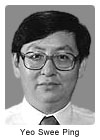Awards Gallery
Year 1989
- Ambrose Fleming Premium (1989), IEE Proceedings on Microwaves, Antennas & Propagation, UK
- Marconi Premium (1989), IEE Proceedings on Communications, Radar & Signal Processing, UK

Dr. Yeo Swee Ping
Ambrose Fleming Premium (1989), IEE Proceedings on Microwaves, Antennas & Propagation, UKUsing Least-squares Boundary Residual Method to Model Symmetrical Five-port Waveguide Junction
Abstract >> Using the least-squares boundary residual
method, an electromagnetic model of the
symmetrical 5-port waveguide (E-plane
coupled) junction is developed. The numerical
results obtained from the computer model
are subjected to a series of computational
and experimental tests and found to be
accurate to within ±1%. These theoretical
data can aid the design of a symmetrical
5-port waveguide junction for use as the
essential component of a 6-port reflectometer
system.
Microwaves, Antennas and Propagation,
IEE Proceedings H
Publication Date: April 1987
Volume: 134, Issue 2 on page(s): 116-124
------------------------------------------------------
For further information, please contact:
Dr. Yeo Swee Ping
Email: eleyeosp@nus.edu.sg
Telephone: 6516 2112

Dr. Lawrence Wong
Marconi Premium (1989), IEE Proceedings on Communications, Radar & Signal Processing, UKLogarithmic PCM Weighted QAM Transmission Over Gaussian and Rayleigh Fading Channels
Abstract >> The transmission of 8-bit µ-law PCM signals
using M-level weighted QAM (WQAM), M =16,
64 and 256, over Gaussian and Rayleigh
fading channels is examined. The weighting
process modifies the positions of the
QAM constellation points so that the overall
distortion in the recovered information-bearing
source signal is reduced. The PCM bits
are mapped to the WQAM points such that
the most significant bits have a lower
probability of being in error than the
least significant bits. Gray coding of
the constellation points is also used.
The WQAM systems have been optimised for
the same average signal energy per transmitted
symbol as for unweighted QAM. Optimised
systems have also been derived for the
same peak signal energy per symbol. The
theoretical and simulation results using
speech indicate that 16-level and 256-level
WQAM have a gain of up to 3 and 5dB, respectively,
over unweighted QAM for the Gaussian channel.
The gains due to weighting for 16-level
QAM operating over an ideal slow Rayleigh
fading channel are up to 5 dB.
Communications, Radar and Signal Processing,
IEE Proceedings F
Publication Date: October 1987
Volume: 134, Issue 6 on page(s): 557-570
------------------------------------------------------
For further information, please contact:
Dr. Lawrence Wong
Email: elewwcl@nus.edu.sg
Telephone: 6516 2108
|


